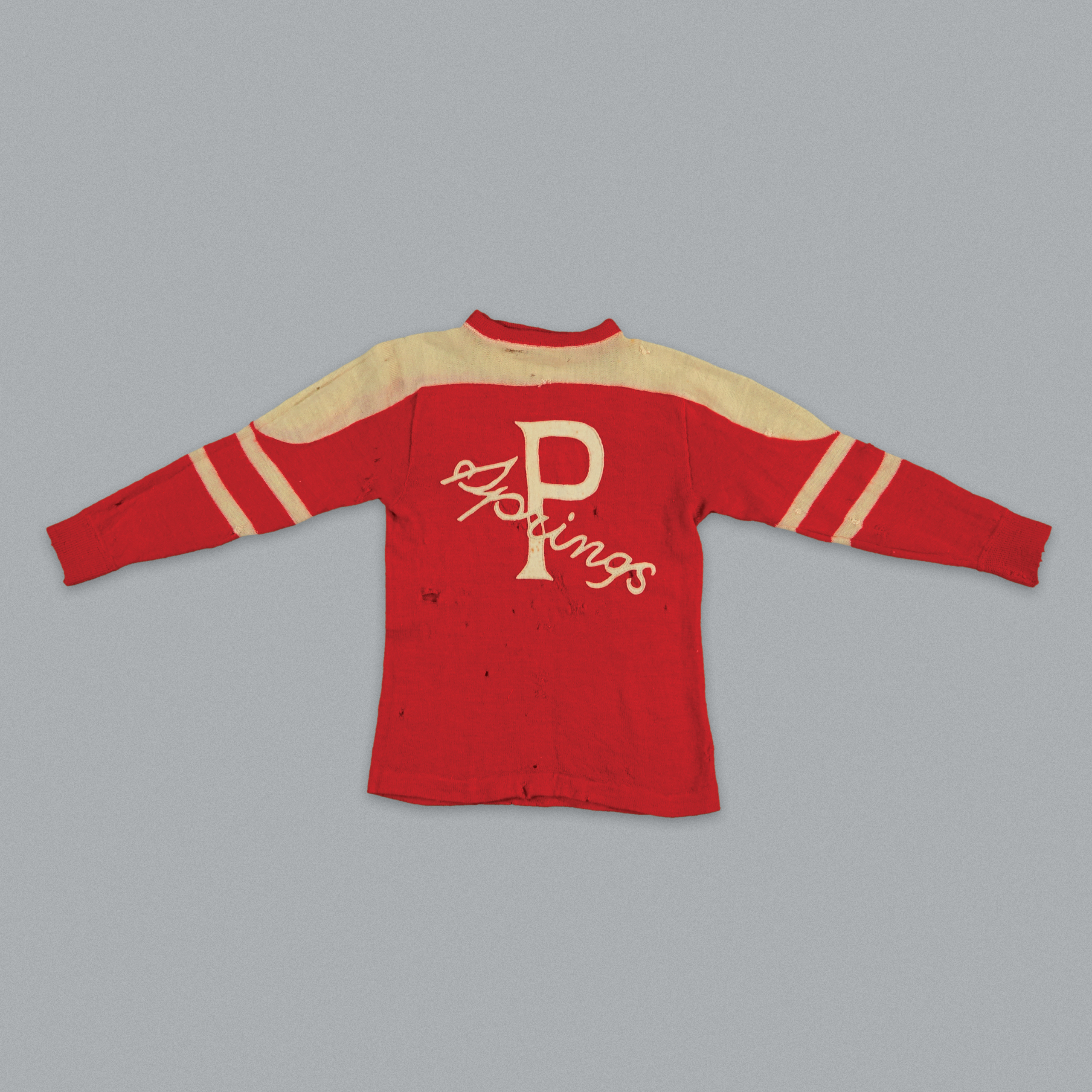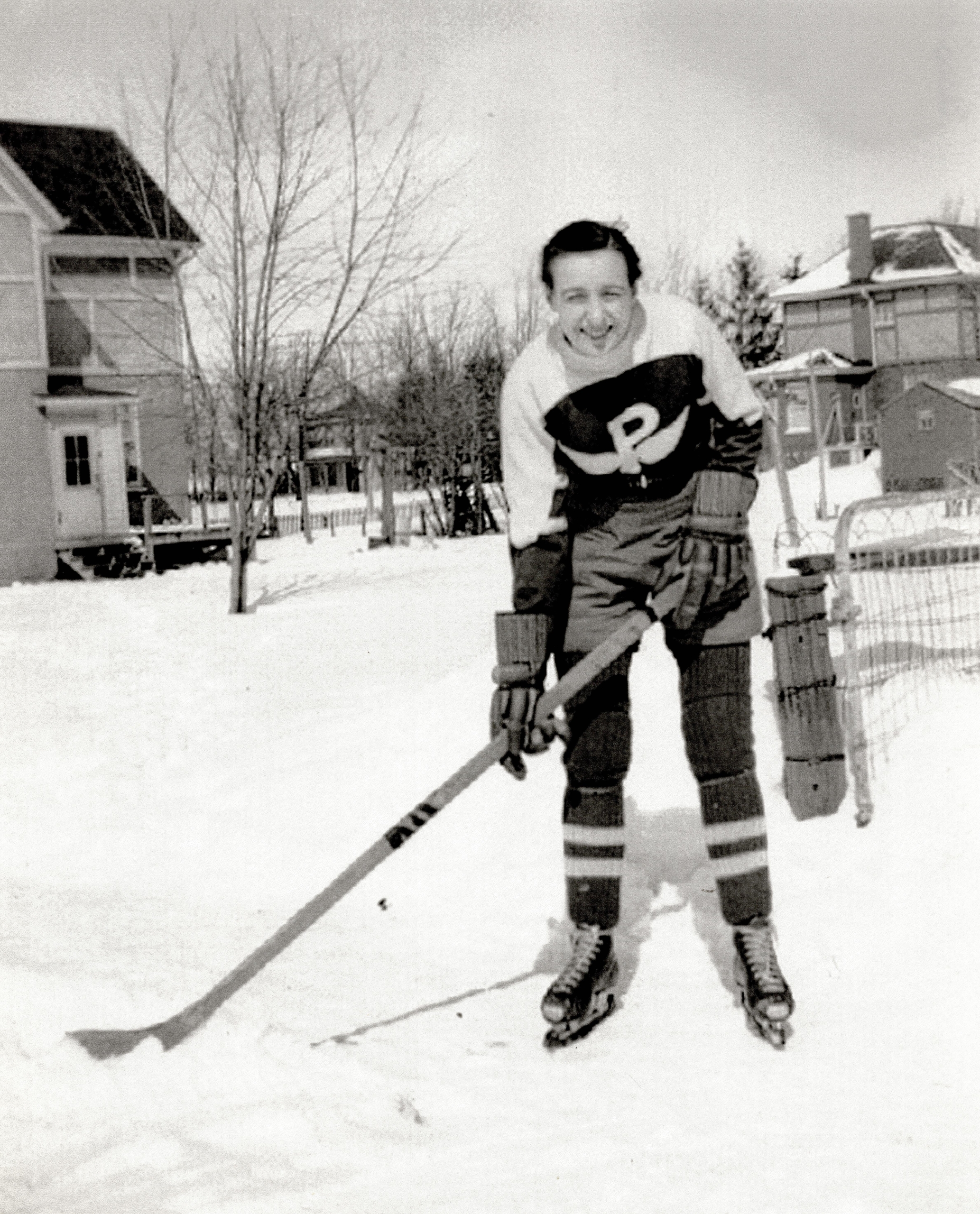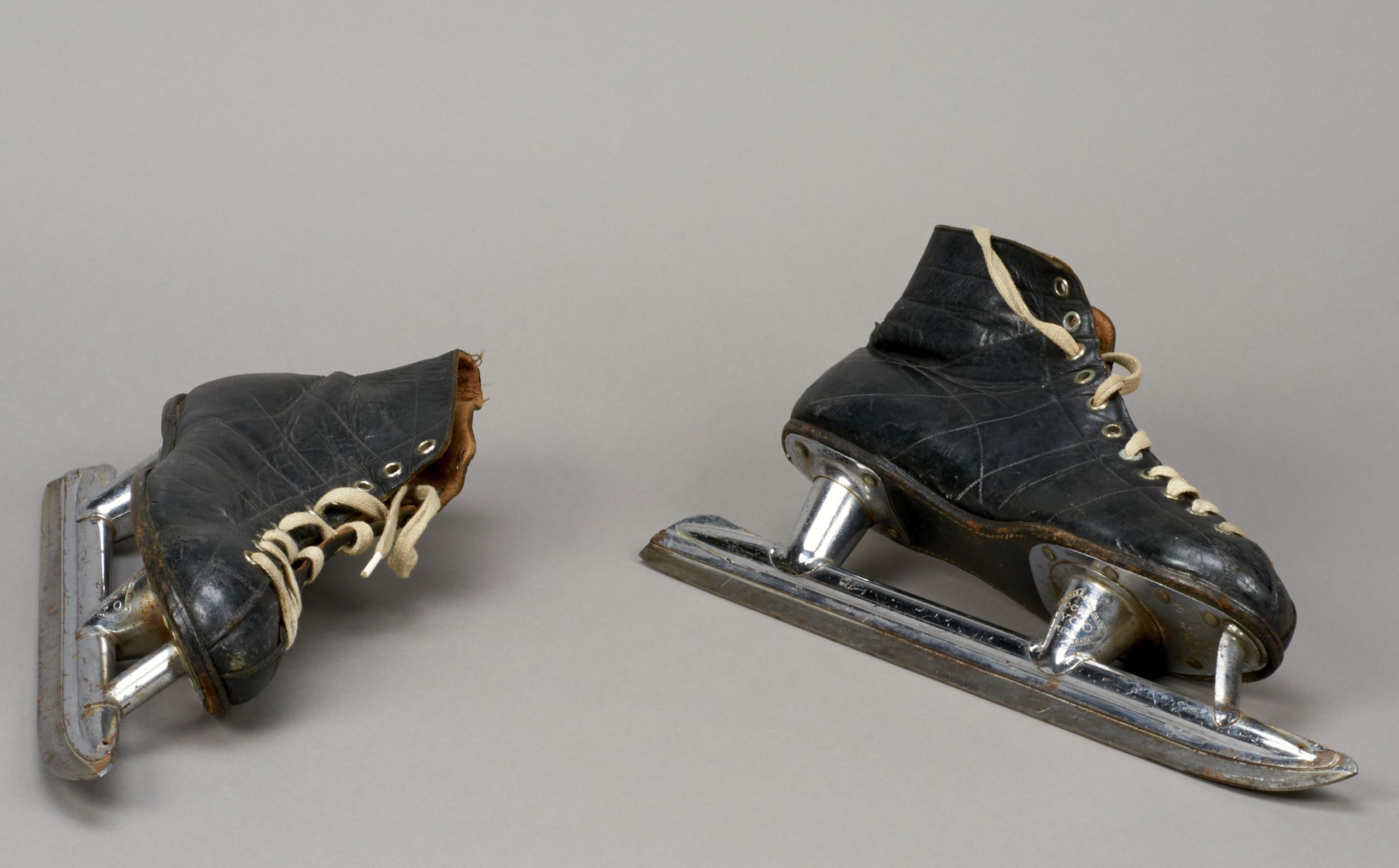Hockey Sweater
Artifact
Image
Video
Audio
 Activities
Activities
LOOK
Look closely at this object. What time period do you think it’s from? What clues does the object give you? Verify your answer by looking at the Historical Context below.
THINK
How has women’s sport changed in Canada since the 1930s? Use evidence found in the Historical Context below to inform your answer.
Details
 Materials
Materials - Wool
Historical Context
Choose one of the three levels below to match your needs.
- This hockey sweater was worn by Hilda Ranscombe, star player for the Preston Rivulettes, during her 1937–1938 hockey season.
- This jersey was controversial because it included the name of the team’s sponsor — the Preston Springs Hotel — which was forbidden in the amateur league.
- Thousands of fans paid to see the Rivulettes and other women’s teams play hockey in the 1930s.
Scroll through the media carousel above to see a photo of Hilda Ranscombe wearing a Preston jersey, and a pair of skates worn by a Preston Springs player.
This hockey sweater was worn by Hilda Ranscombe, star player for the Preston Rivulettes, during her 1937–1938 hockey season.
In 1938, Preston Rivulettes players were forbidden to wear their jerseys in the national women’s championship because the jerseys referenced the name of the team’s sponsor: the Preston Springs Hotel. The Dominion Women’s Amateur Hockey Association prohibited sponsorship or any pay for athletes, fearing it might compromise the athletes’ integrity. But the team members — most of them factory workers — badly needed support during the Great Depression.
Thousands of fans paid to see the Rivulettes and other women’s teams play hockey in the 1930s. Following their heyday in the 1930s, women’s hockey leagues all but disappeared during the Second World War. Teams were formed during the 1940s and 1950s, but there were few tournaments and no new women’s leagues were formed until the 1970s. Since 1990, however, registration in girls’ and women’s hockey has increased dramatically.
This hockey sweater was worn by Hilda Ranscombe, star player for the Preston Rivulettes, during her 1937–1938 hockey season.
In 1938, players for the Preston Rivulettes were forbidden to wear their jerseys during the national women’s championship, because the jerseys referenced the name of the team’s sponsor: the Preston Springs Hotel. The Rivulettes had added “Springs” to their jerseys in exchange for money to buy new equipment.
The problem? The Dominion Women’s Amateur Hockey Association prohibited sponsorship, or any pay, for athletes, fearing it might compromise the athletes’ integrity. But the team members — most of them factory workers — badly needed support during the Great Depression.
In the end, Rivulettes players wore the “Springs” jerseys during the regular season, but borrowed other jerseys for the championship tournament. In spite of the controversy, they took home the Lady Bessborough Trophy in 1938: an annual award for Canada’s national women’s hockey champions.
Thousands of fans paid to see the Rivulettes and other women’s teams play hockey in the 1930s. Local and national newspapers covered the women’s games, and victories were publicly celebrated, with players becoming local celebrities.
Following their heyday in the 1930s, women’s hockey leagues all but disappeared during the Second World War. Teams were formed during the 1940s and 1950s, but there were few tournaments, and no new women’s leagues were formed until the 1970s. Since 1990, however, registration in girls’ and women’s hockey has increased tenfold.
- This hockey sweater was worn by Hilda Ranscombe, star player for the Preston Rivulettes, during her 1937–1938 hockey season.
- This jersey was controversial because it included the name of the team’s sponsor — the Preston Springs Hotel — which was forbidden in the amateur league.
- Thousands of fans paid to see the Rivulettes and other women’s teams play hockey in the 1930s.
Scroll through the media carousel above to see a photo of Hilda Ranscombe wearing a Preston jersey, and a pair of skates worn by a Preston Springs player.
This hockey sweater was worn by Hilda Ranscombe, star player for the Preston Rivulettes, during her 1937–1938 hockey season.
In 1938, Preston Rivulettes players were forbidden to wear their jerseys in the national women’s championship because the jerseys referenced the name of the team’s sponsor: the Preston Springs Hotel. The Dominion Women’s Amateur Hockey Association prohibited sponsorship or any pay for athletes, fearing it might compromise the athletes’ integrity. But the team members — most of them factory workers — badly needed support during the Great Depression.
Thousands of fans paid to see the Rivulettes and other women’s teams play hockey in the 1930s. Following their heyday in the 1930s, women’s hockey leagues all but disappeared during the Second World War. Teams were formed during the 1940s and 1950s, but there were few tournaments and no new women’s leagues were formed until the 1970s. Since 1990, however, registration in girls’ and women’s hockey has increased dramatically.
This hockey sweater was worn by Hilda Ranscombe, star player for the Preston Rivulettes, during her 1937–1938 hockey season.
In 1938, players for the Preston Rivulettes were forbidden to wear their jerseys during the national women’s championship, because the jerseys referenced the name of the team’s sponsor: the Preston Springs Hotel. The Rivulettes had added “Springs” to their jerseys in exchange for money to buy new equipment.
The problem? The Dominion Women’s Amateur Hockey Association prohibited sponsorship, or any pay, for athletes, fearing it might compromise the athletes’ integrity. But the team members — most of them factory workers — badly needed support during the Great Depression.
In the end, Rivulettes players wore the “Springs” jerseys during the regular season, but borrowed other jerseys for the championship tournament. In spite of the controversy, they took home the Lady Bessborough Trophy in 1938: an annual award for Canada’s national women’s hockey champions.
Thousands of fans paid to see the Rivulettes and other women’s teams play hockey in the 1930s. Local and national newspapers covered the women’s games, and victories were publicly celebrated, with players becoming local celebrities.
Following their heyday in the 1930s, women’s hockey leagues all but disappeared during the Second World War. Teams were formed during the 1940s and 1950s, but there were few tournaments, and no new women’s leagues were formed until the 1970s. Since 1990, however, registration in girls’ and women’s hockey has increased tenfold.
Summary
- This hockey sweater was worn by Hilda Ranscombe, star player for the Preston Rivulettes, during her 1937–1938 hockey season.
- This jersey was controversial because it included the name of the team’s sponsor — the Preston Springs Hotel — which was forbidden in the amateur league.
- Thousands of fans paid to see the Rivulettes and other women’s teams play hockey in the 1930s.
Scroll through the media carousel above to see a photo of Hilda Ranscombe wearing a Preston jersey, and a pair of skates worn by a Preston Springs player.
Essential
This hockey sweater was worn by Hilda Ranscombe, star player for the Preston Rivulettes, during her 1937–1938 hockey season.
In 1938, Preston Rivulettes players were forbidden to wear their jerseys in the national women’s championship because the jerseys referenced the name of the team’s sponsor: the Preston Springs Hotel. The Dominion Women’s Amateur Hockey Association prohibited sponsorship or any pay for athletes, fearing it might compromise the athletes’ integrity. But the team members — most of them factory workers — badly needed support during the Great Depression.
Thousands of fans paid to see the Rivulettes and other women’s teams play hockey in the 1930s. Following their heyday in the 1930s, women’s hockey leagues all but disappeared during the Second World War. Teams were formed during the 1940s and 1950s, but there were few tournaments and no new women’s leagues were formed until the 1970s. Since 1990, however, registration in girls’ and women’s hockey has increased dramatically.
In-Depth
This hockey sweater was worn by Hilda Ranscombe, star player for the Preston Rivulettes, during her 1937–1938 hockey season.
In 1938, players for the Preston Rivulettes were forbidden to wear their jerseys during the national women’s championship, because the jerseys referenced the name of the team’s sponsor: the Preston Springs Hotel. The Rivulettes had added “Springs” to their jerseys in exchange for money to buy new equipment.
The problem? The Dominion Women’s Amateur Hockey Association prohibited sponsorship, or any pay, for athletes, fearing it might compromise the athletes’ integrity. But the team members — most of them factory workers — badly needed support during the Great Depression.
In the end, Rivulettes players wore the “Springs” jerseys during the regular season, but borrowed other jerseys for the championship tournament. In spite of the controversy, they took home the Lady Bessborough Trophy in 1938: an annual award for Canada’s national women’s hockey champions.
Thousands of fans paid to see the Rivulettes and other women’s teams play hockey in the 1930s. Local and national newspapers covered the women’s games, and victories were publicly celebrated, with players becoming local celebrities.
Following their heyday in the 1930s, women’s hockey leagues all but disappeared during the Second World War. Teams were formed during the 1940s and 1950s, but there were few tournaments, and no new women’s leagues were formed until the 1970s. Since 1990, however, registration in girls’ and women’s hockey has increased tenfold.



